Amphibians
This
page was born 12/02/2009. Rickubis designed it.
(such as it
is.) Last update: 3/25/2024
Images
and contents on this page copyright ©2002-2024 Richard M. Dashnau
Update 03/19/2024 - 03/10/2024
Brazos Bend State Park I was watching various wading
birds in Pilant Slough near the Observation Tower at 40 Acre Lake. They
were
foraging
on the floating plant mats. I like to watch this
behavior to
see what the birds are catching. The birds move quickly, and there are
many of them, so it takes some
luck for me to be watching the right
bird at the right time to see a successful capture of prey.
It
takes even more luck to catch it with a camera. For a long time
(years?) I've
been hoping to film the capture of one specific
animal--and today I was successful! The pictures on not very
good, but they are still clear enough for me to identify the
prey. The Great Blue Heron, Ardea
herodias
was at least 25 yards away, and I shot a burst of photos when it
grabbed something. I couldn't identify the prey until I got
home
and examined the photos. The images below were taken as a single burst
of photos (at 10 images per second); so the prey was gone in less than
a second.
What was it? The Great Blue Heron had caught and eaten an
Eastern Newt, Notophthalmus
viridescens. I've known the newts live here.
We've caught them during our
Pond Life Programs.
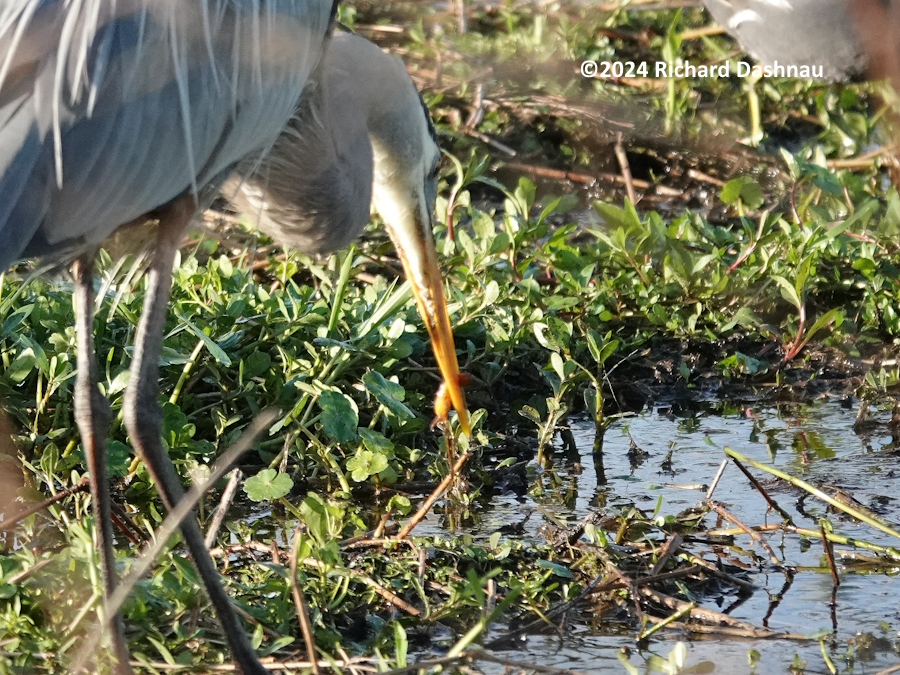
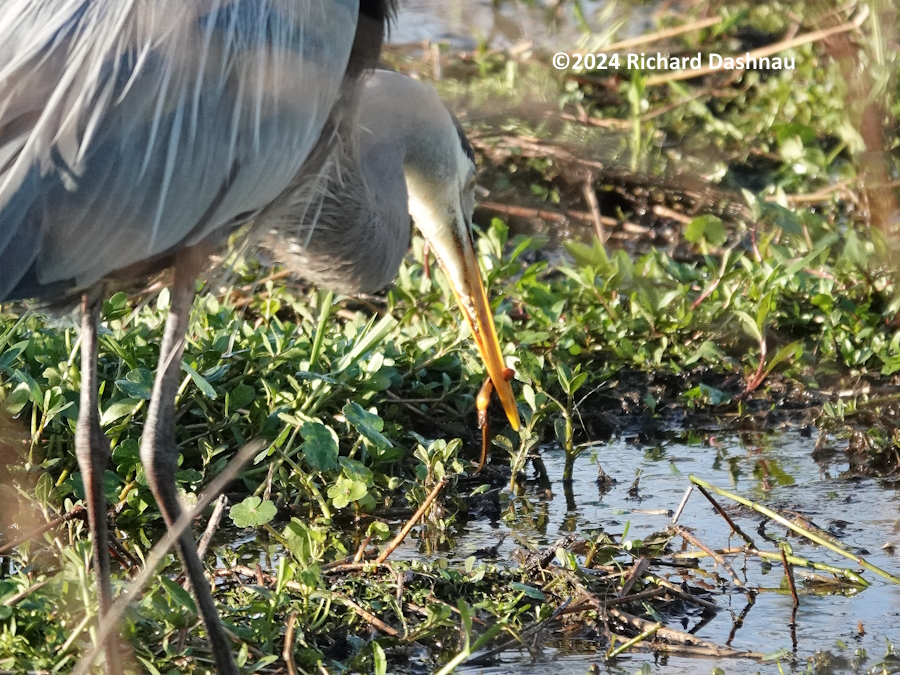
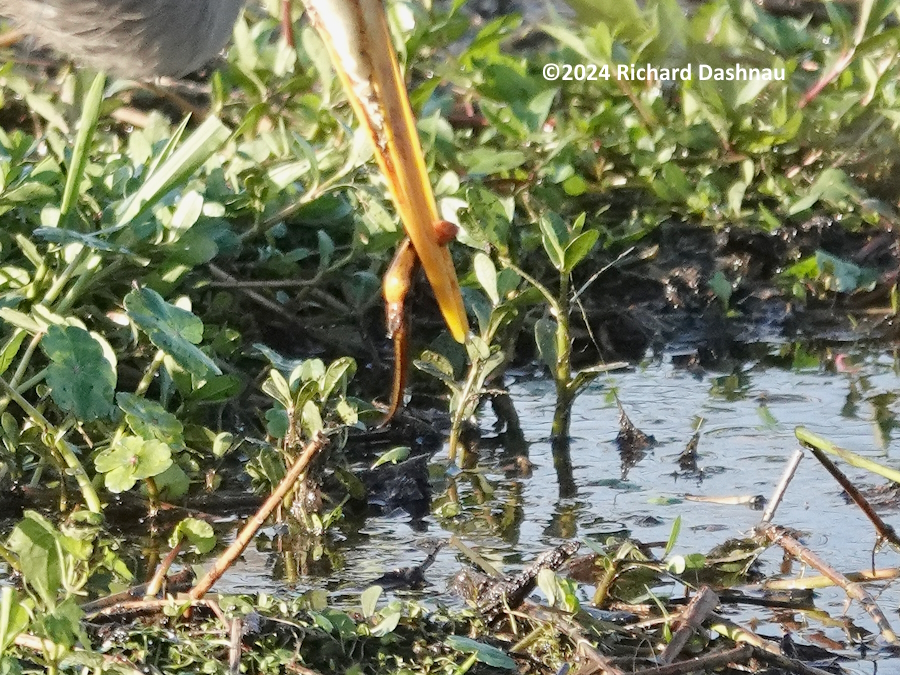
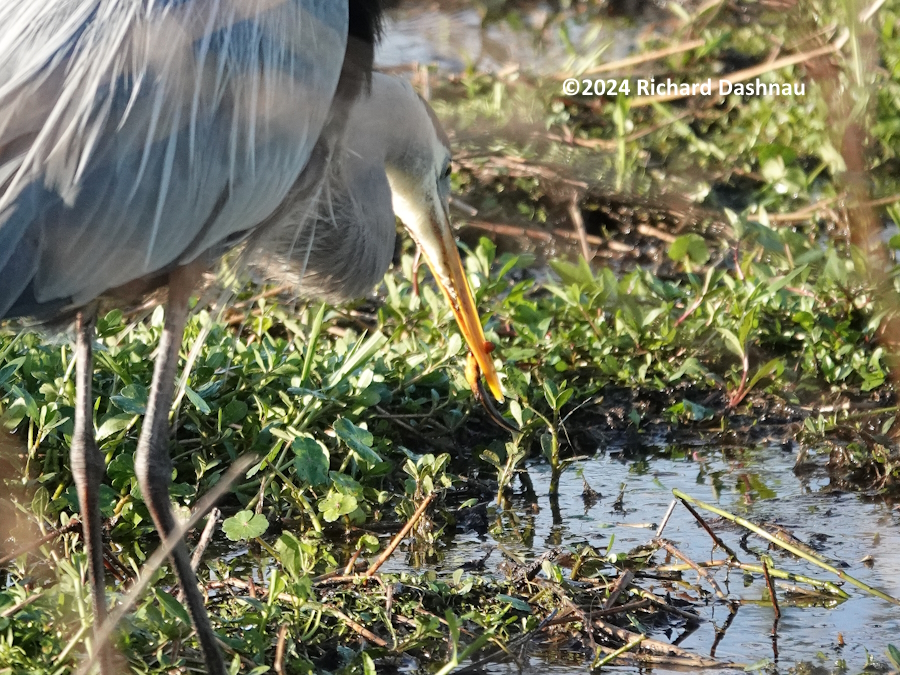
While
growing up in the Northeast U.S., I'd found the newts many times, and
had kept them briefly. I'd also found Red Efts up there, and in that
environment I'd found them
nearly the size of adult newts, and VERY
bright orange. I had learned that the Eft stage was toxic,
and
the orange was a "warning" color (this is called "aposematic"
coloration).
Here's an study:
"Chemical Defense of the Eastern
Newt (Notophthalmus viridescens): Variation in Efficiency against
Different Consumers and in Different Habitats" by Zachary H. Marion,
Mark E. Hay.
If you'd like to read it, here's an open-source link(my favorite
kind): https://www.ncbi.nlm.nih.gov/pmc/articles/PMC3229496/
From this study (notes in [[double
brackets]] are just my own comments):
1) "Like Taricha newts, the eastern newt (Notophthalmus viridescens)
is assumed to deter predators by secreting TTX, with all life-history
stages reportedly unpalatable to a variety of vertebrate
and invertebrate predators. " [[ TTX=tetrodotoxin. They
are toxic at *all* stages!?!? ]]
2) "The lack of rigorous research on the chemically-mediated
predator-prey interactions involving Notophthalmus viridescens
is surprising given that eastern newts are thought of as keystone
predators
that regulate the diversity and abundance of larval anurans, aquatic
invertebrates, and the ecosystem functions of some freshwater
environments." [[
*Keystone predators*!? This little
amphibian? What a
great example of how much a single organism can affect pond life. ]]
3) "The eastern newt (Notophthalmus
viridescens Rafinesque, Salamandridae) is one of the most
widely distributed salamanders in North America and occupies lentic
environments
across the spectrum from temporary to permanent water
bodies." [[
Where I come from, I knew them as "Red-Spotted Newt", but they're the
same species. ]]
4) " Notophthalmus
viridescens
secrete tetrodotoxin (TTX) which could serve as a chemical defense
against predators. Concentrations of TTX are greatest in the red eft
stage,
followed by adults, eggs, and finally larvae." [[ As stated above, TTX is
in all stages, although greatest in the red eft stage (which has the
warning colors). ]]
5) " To assess newt palatability to co-occurring consumers, we used
adult largemouth bass (Micropterus
salmoides; 15–20 cm standard length [SL]), juvenile
bluegill sunfish (Lepomis
macrochirus; 2–4 cm
SL), the crayfish Procambarus
clarkii (9–12 cm total length), and adult bullfrogs (Lithobates catesbeianus;
12.5–18 cm snout-vent length)." [[ The list of predators
that they used are all inhabitants at BBSP also.
The
crayfish is our big Red Swamp Crawfish. It is native here, and the same
species that is cultivated and served in restaurants. ]]
6)
"Here we show that eastern newts, their early ontogeny, and especially
their dorsal skin areas are distasteful to common aquatic consumers
such as fish and crayfish, that fish avoid newts due
to
chemical deterrents, and that the compound TTX can produce this
response at small portions of its reported natural concentrations. Yet
some consumers, such as bullfrogs and possibly
other reptiles and
amphibians, appear undeterred by TTX." (page 6)
7) "Our results show that the newt Notophthalmus
viridescens
is unpalatable to fishes and a crayfish, and that this unpalatability
is chemical in nature, is concentrated in exterior dorsal skin, and is
likely
due to TTX or related secondary metabolites. However, this chemical
defense is ineffective against bullfrogs (and possibly turtles),
allowing considerable consumption of tethered newts in
the field." (page 7)
From
my observation here, I can add Great Blue Herons to the list of
predators that eat Newts. The last two images below show that
the
Newt was swallowed (its head is
visible in image #3), and it was
gone after image #4 and the images that followed (not shown here).
It does make me wonder if the TTX has any effect on the
Herons
after
they've eaten a newt. I have seen other wading birds catch newts but it
has been a very rare observation, and I have never been able to capture
it on film before.
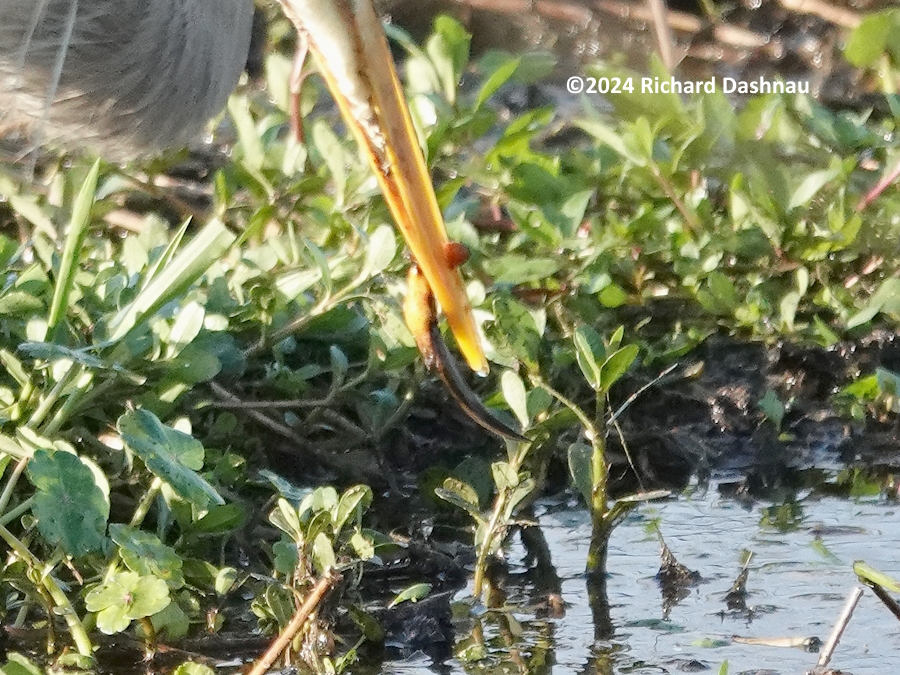
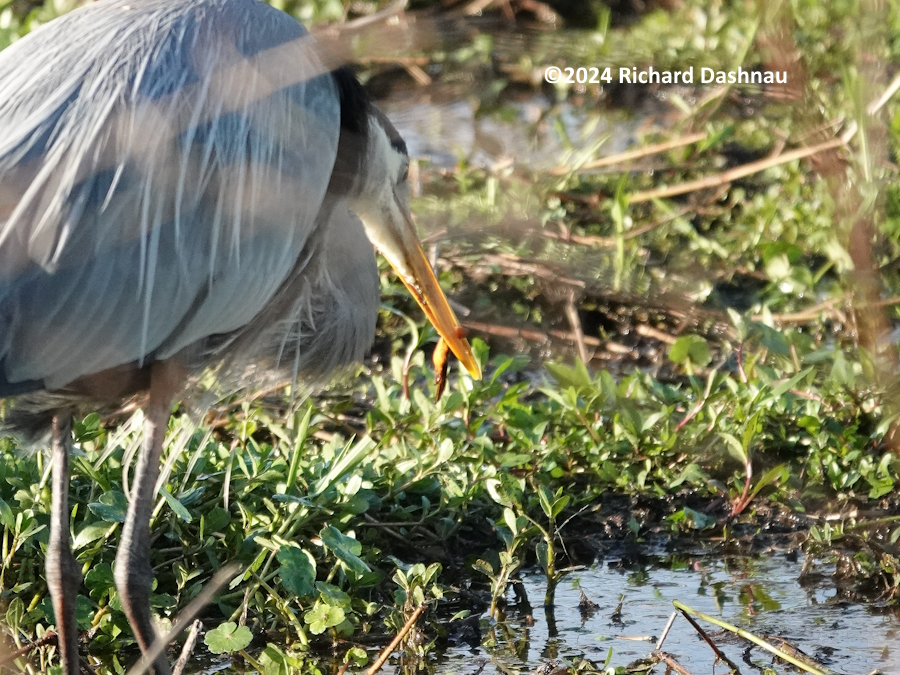
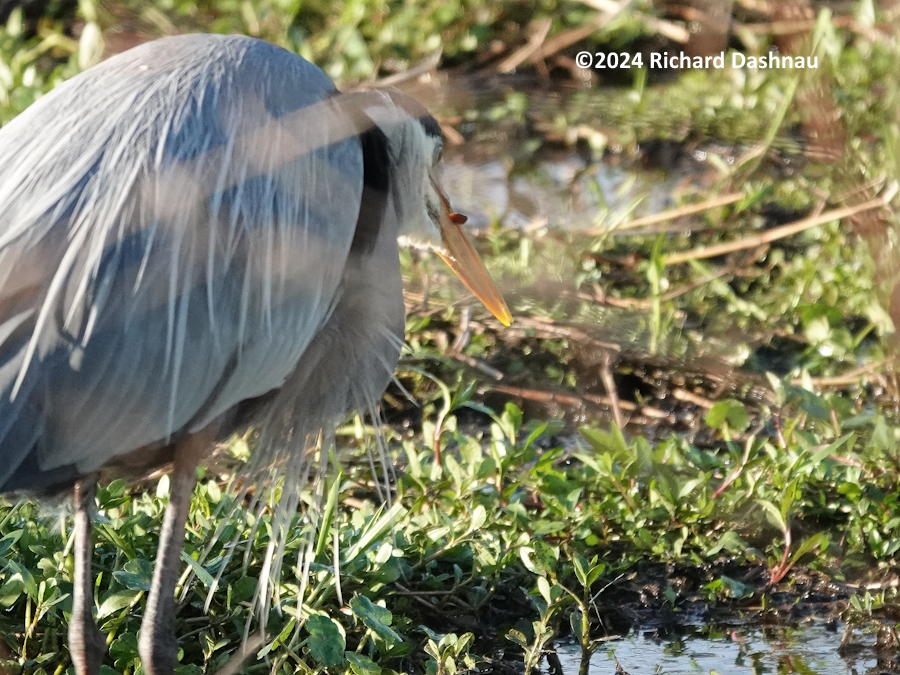
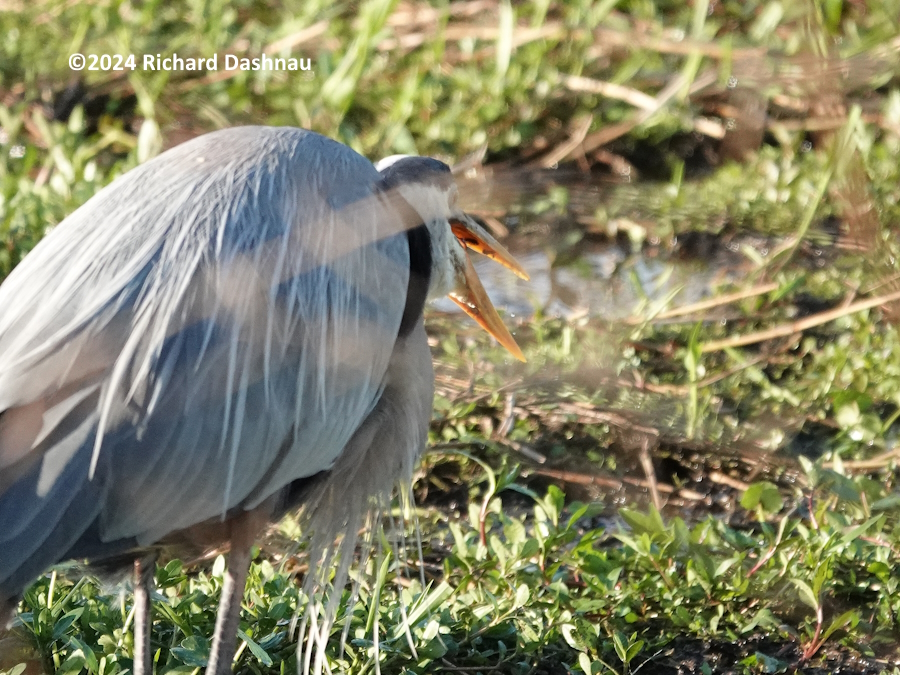
Here's an Eastern Newt, Notophthalmus viridescens, that we caught at during a Pond Life Program a few weeks later, on 03/24/2024 .
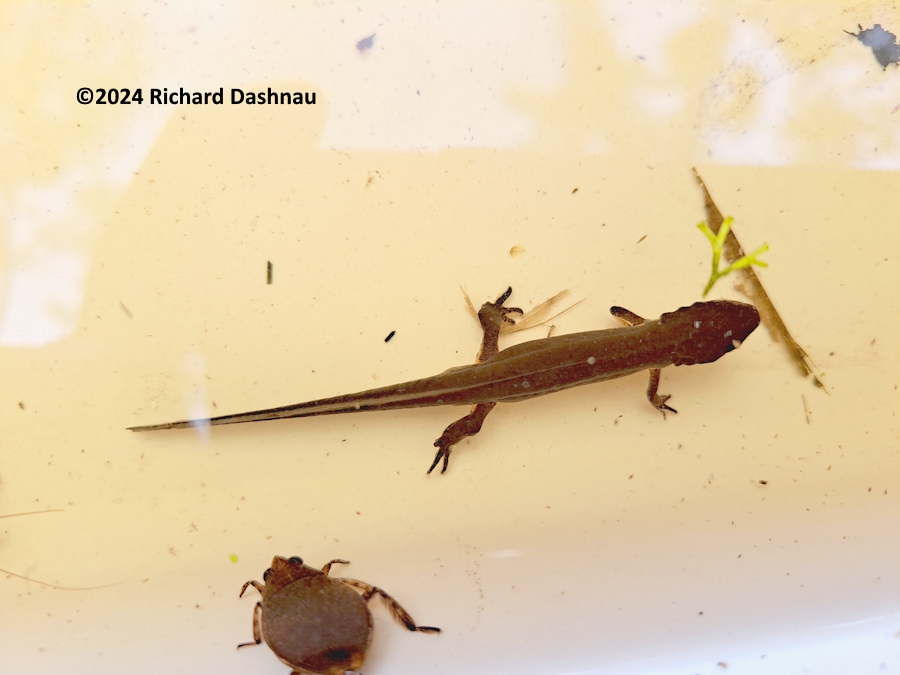
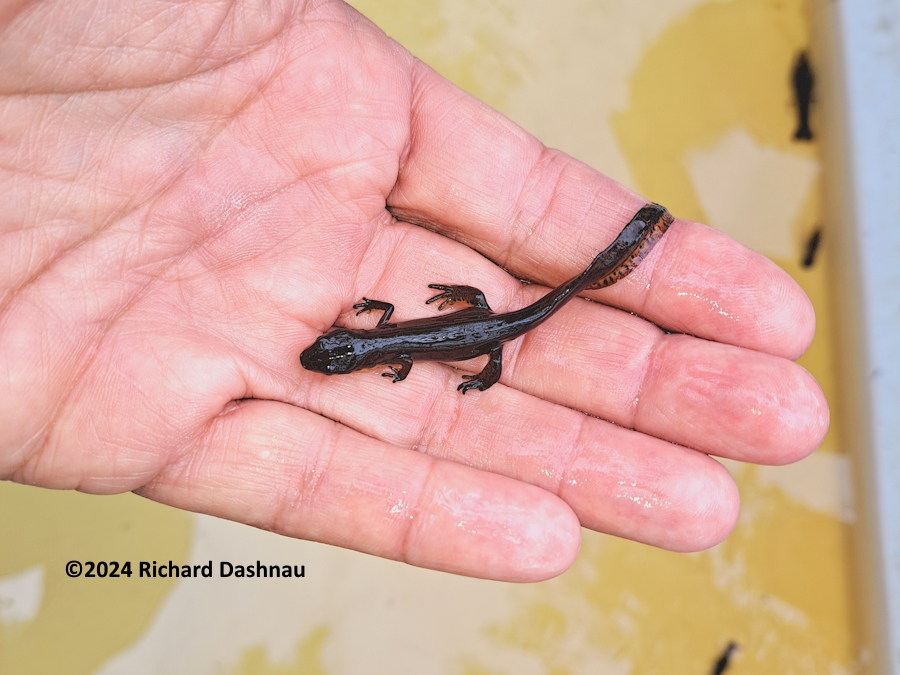
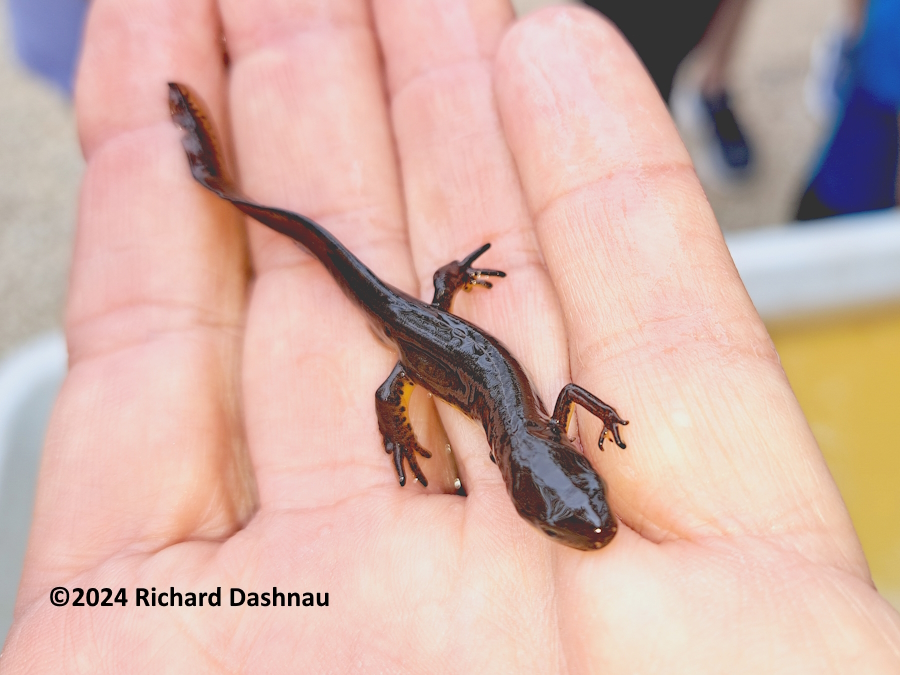
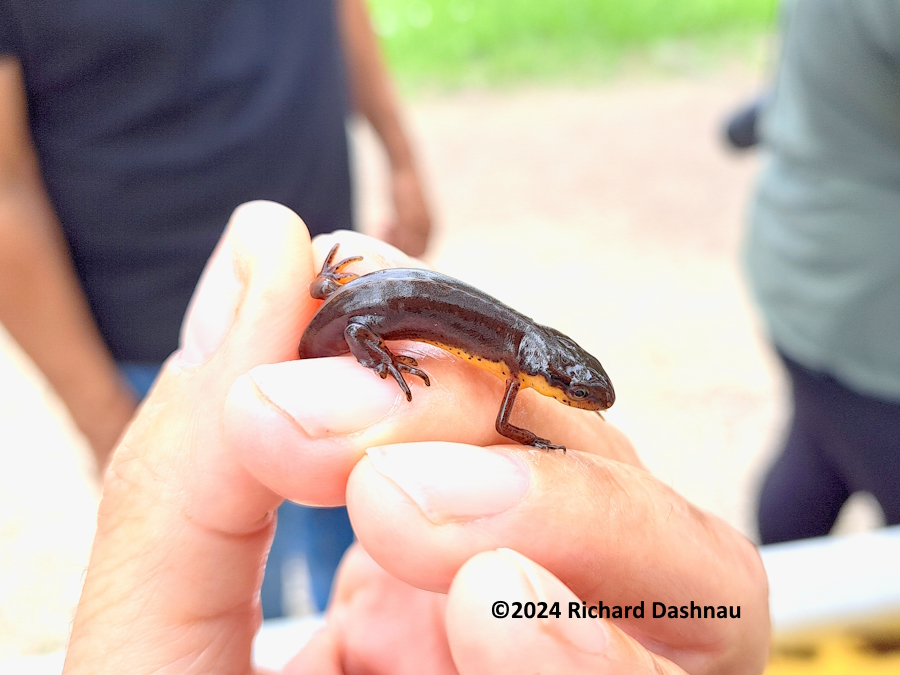
01/30/2022 Speaking
of Sirens (Lesser Siren-Siren intermedia)--I spent some hours near the
mother alligator and her den. While I was there, I discovered
a
partially-eaten carcass of a Siren.
I don't know how it got there,
but it was an interesting interpretive subject of a few minutes.
Then I had to wash the slime and other fluids off my hands.
Fortunately I always have a bottle of hand
disinfectant with me--and
one of the visitors also gave me a wet wipe, so I could handle my
camera without getting it covered with slime.
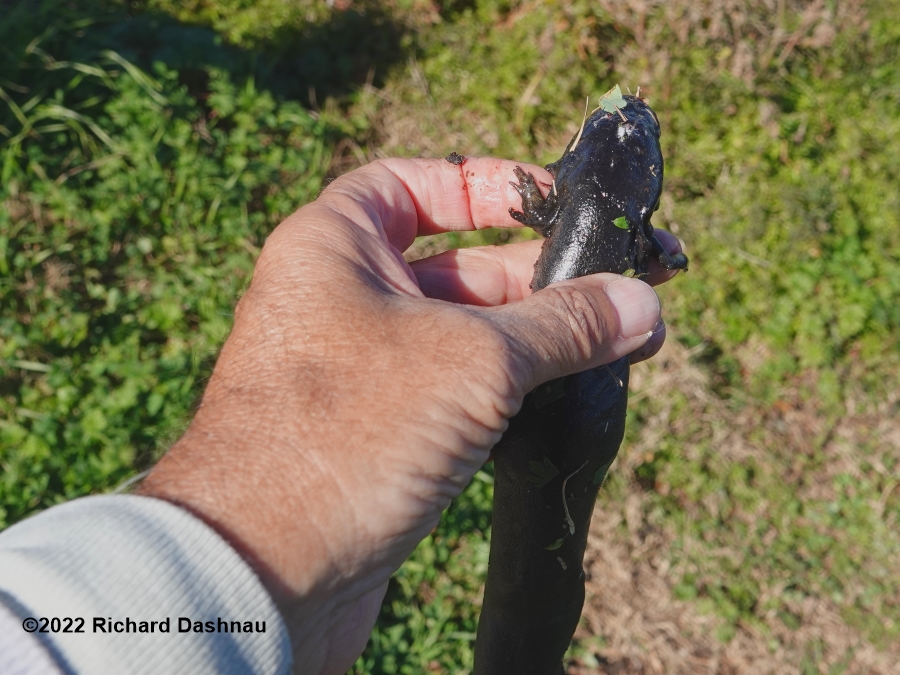
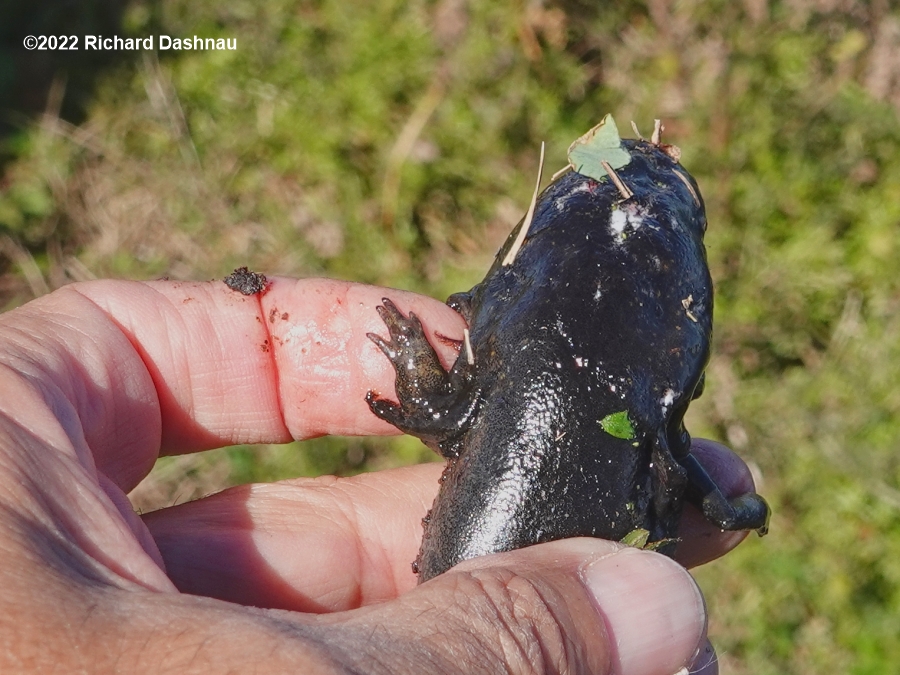
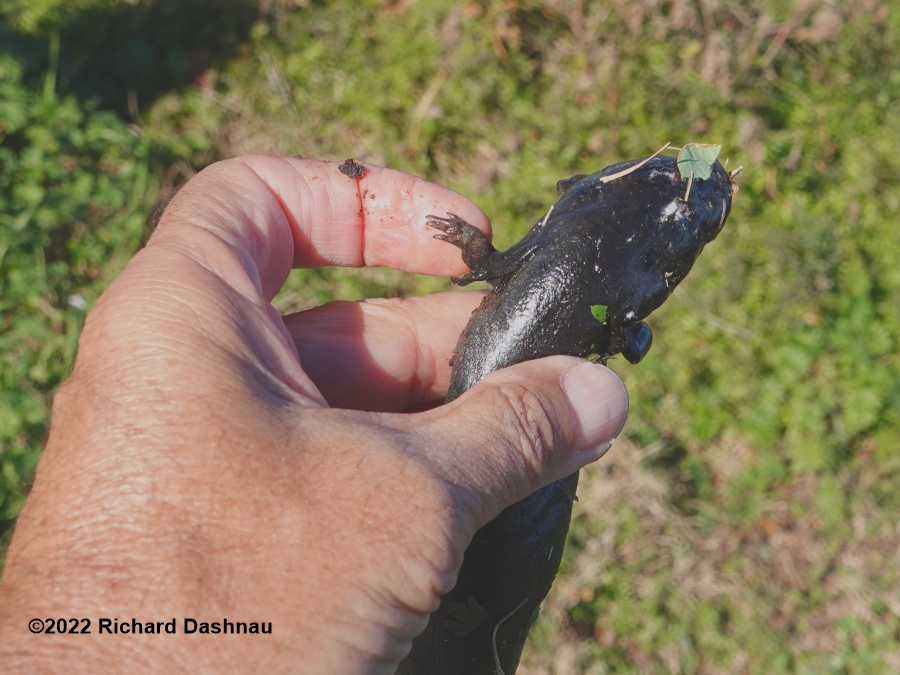
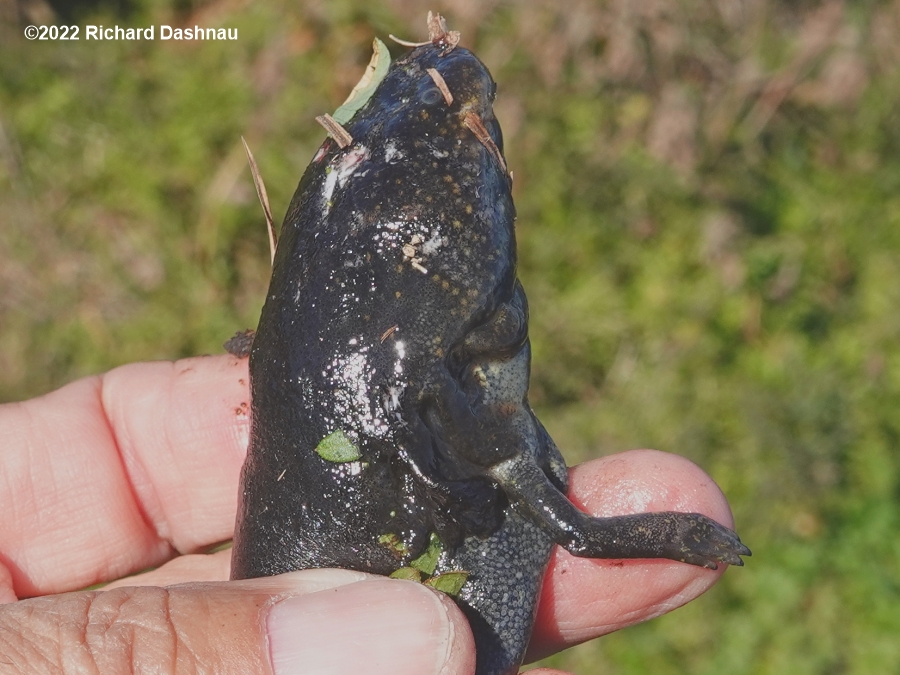
I
usually only see Sirens when one of the wading birds has caught
one. Wading birds (Herons, Egrets, Bitterns) do not usually
break
their prey into small pieces, or bite off parts. Sometimes
they
may discard spines or legs. So, I didn't think that one of those had
partially-eaten the siren. But something (such as a Caracara) could
have stolen the Siren from a wading bird. Anyway,
I could use the
carcass to point out the unique features on this amphibian. The two
front legs with visible toes are distinct. The external gills are also
visible, though not quite as clear, lying
against the skin just above the front legs. I put the carcass back in
the grass where it had been found.
07/19/2021- I
haven't been able to exercise in the area I normally use because it's
been raining. Today, it seemed like the circle had dried
enough
to use,
so I walked around it, clearing sticks and other items.
As I made another circuit, I noticed a round hole.
It was
about 1.5 inches (3.8 cm)across. It was much
too large to be a
cicada exit burrow. My first thought was that it had been a crawfish
burrow (Red Swamp Crawfish Procambarus clarkii) that had had
the
"chimney"
knocked off--perhaps by park mowers. I wasn't wearing my
glasses,
but as I stood above the hole and looked down, I thought there was
something
in there. I retrieved my glasses and a camera from my car,
and returned.
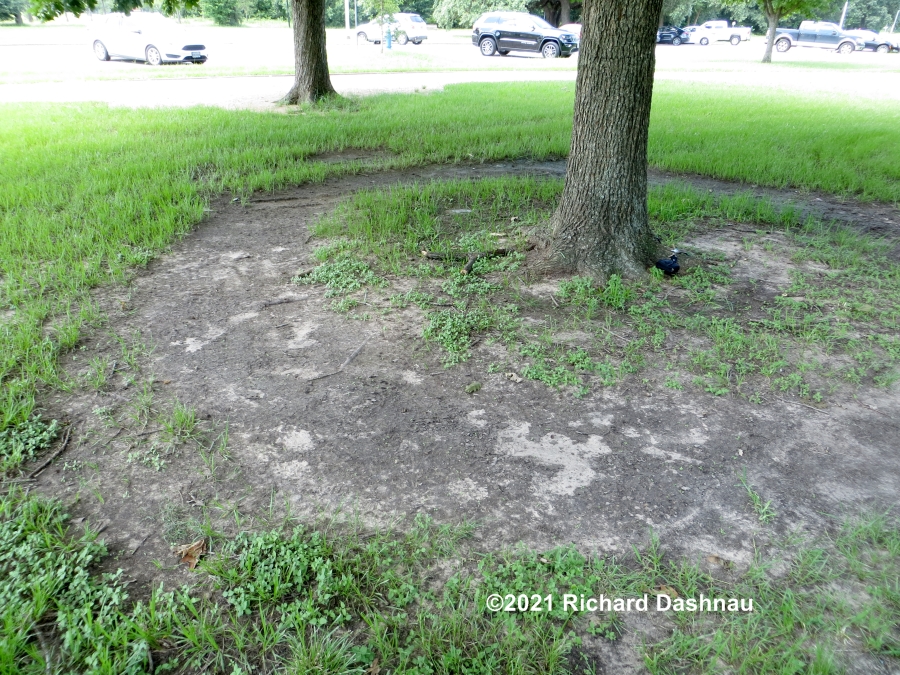
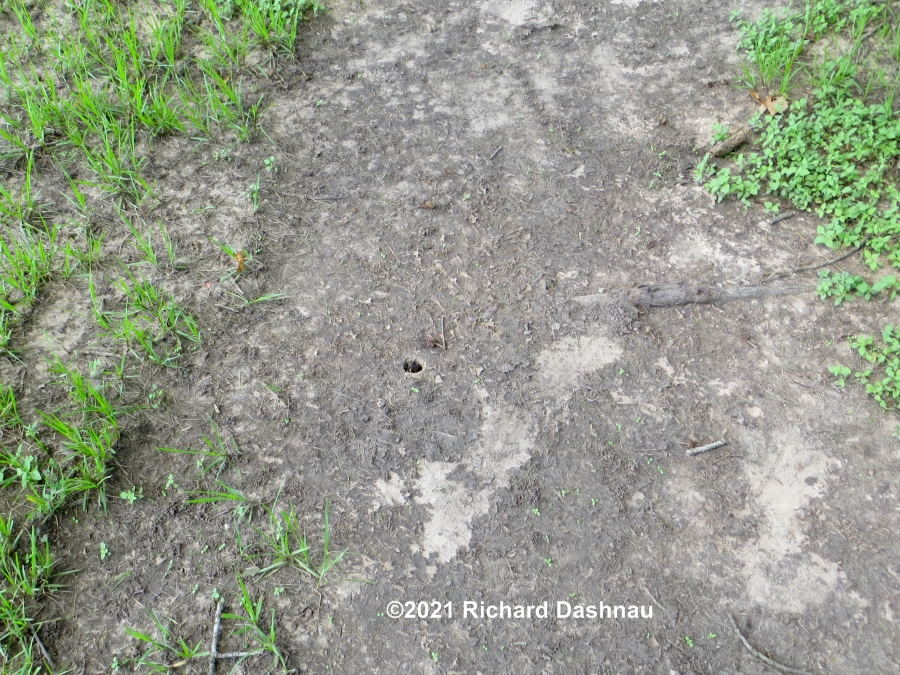
I
stood above the hole, this time wearing my glasses. I bent
and
looked down into it...and something moved. Then, a face
appeared
at the opening! It was a toad!
The little face looked up at me. I'm pretty sure that the
toad made that hole--probably as the water dried and of
course before the mud had hardened. I took
a few more pictures--giving the toad space so I didn't scare it.
Then, I moved my workout to the next tree over. In
the cropped images, I can see a blister at the front
edge of its mouth.
It looks a lot like fire ant blisters I've gotten. Poor little critter.
I've tried to figure out what kind of toad it is.
After
some searching, I've found that it's
probably a Gulf Coast Toad
(aka Coastal Plains Toad; Incilius nebulifer). I can't see the toad's
body, but those prominent bone crests between the eyes seem to be a
defining feature. I found the information in this: A review of the
biology and literature of the Gulf Coast Toad (Incilius nebulifer),
native to Mexico and the United States
by Mendelson, Kinsey et. al.
(Article in Zootaxa � June 2015 DOI: 10.11646/zootaxa.3974.4.4)
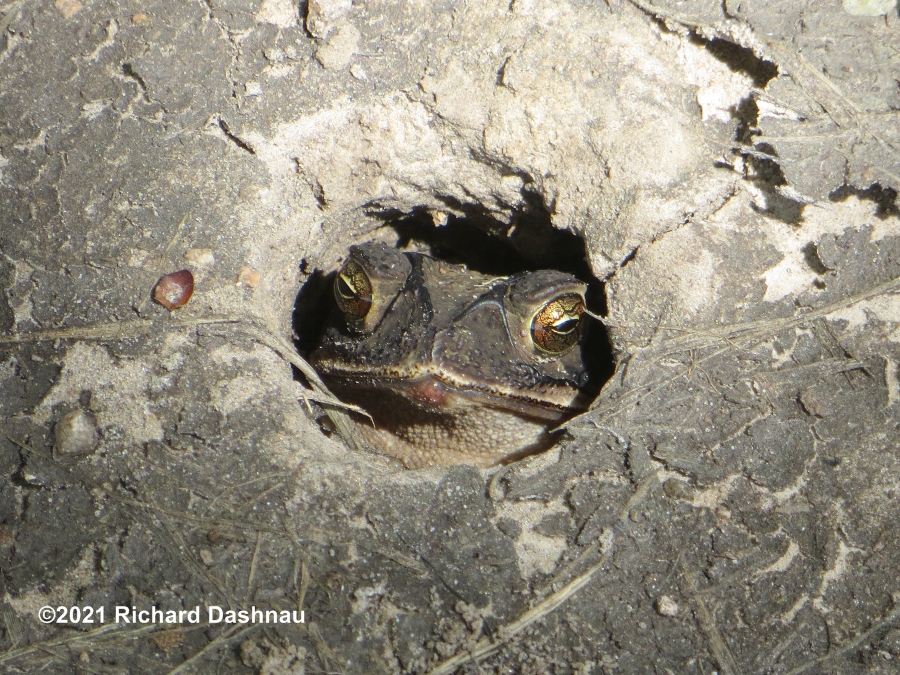
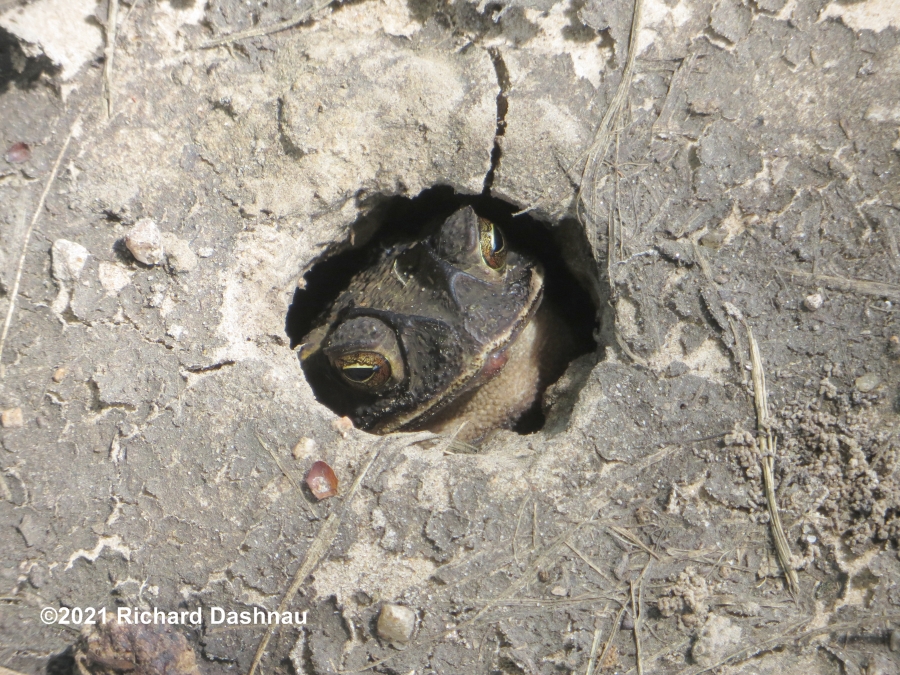
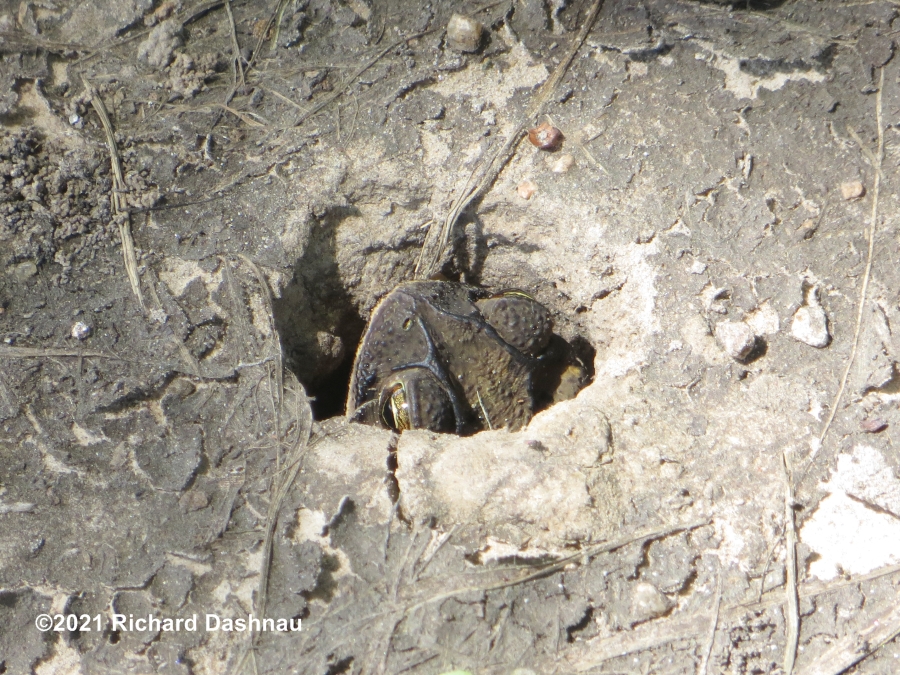
(update 07/20/2021)- I returned the next
day--after all, it's where I regularly practice. I was sad
and a bit relieved to see that the
toad
had left. Relieved, because I thought that the toad was at
risk,
even in the hole. Since the toad had gone, I could examine the hole.
From
the top, the hole is about 3cm across (1.2 inches--I'd estimated 1.5
inches). I tried for pictures into the hole. It does have a
visible
bottom. That "ledge" is probably just a hard area in the
substrate that couldn't be burrowed through.
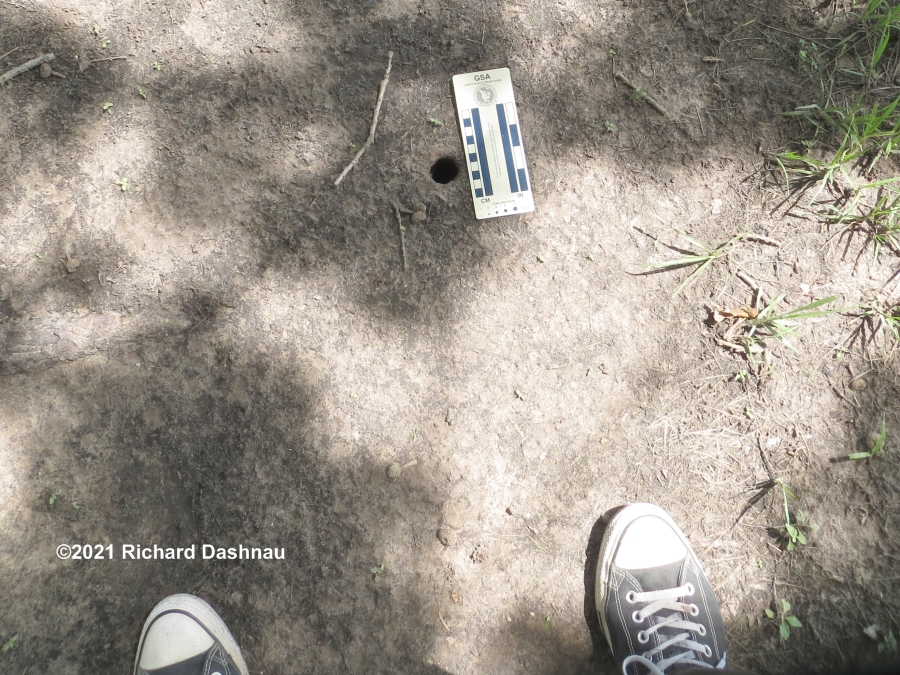
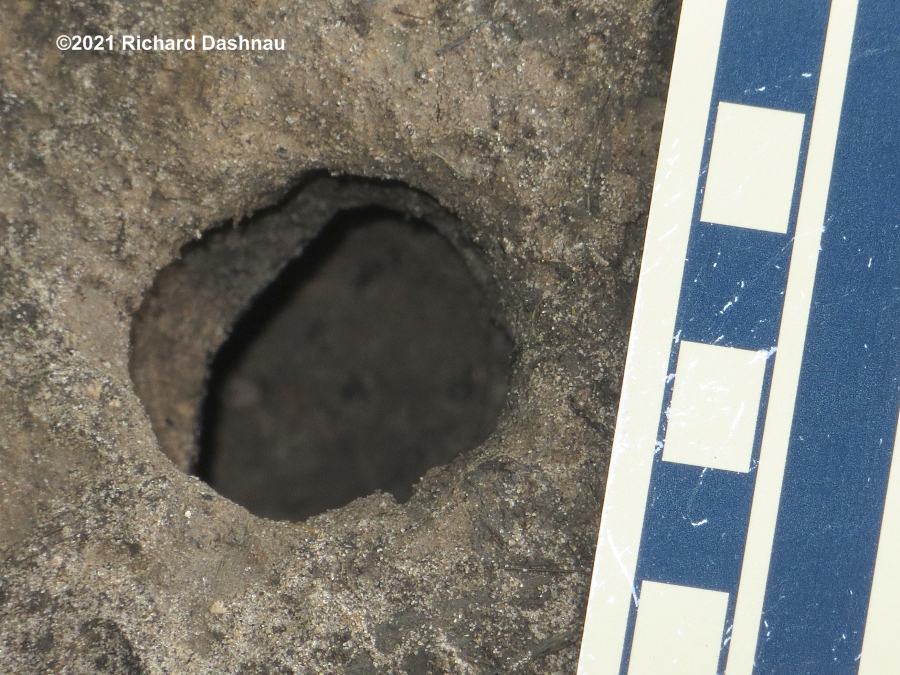
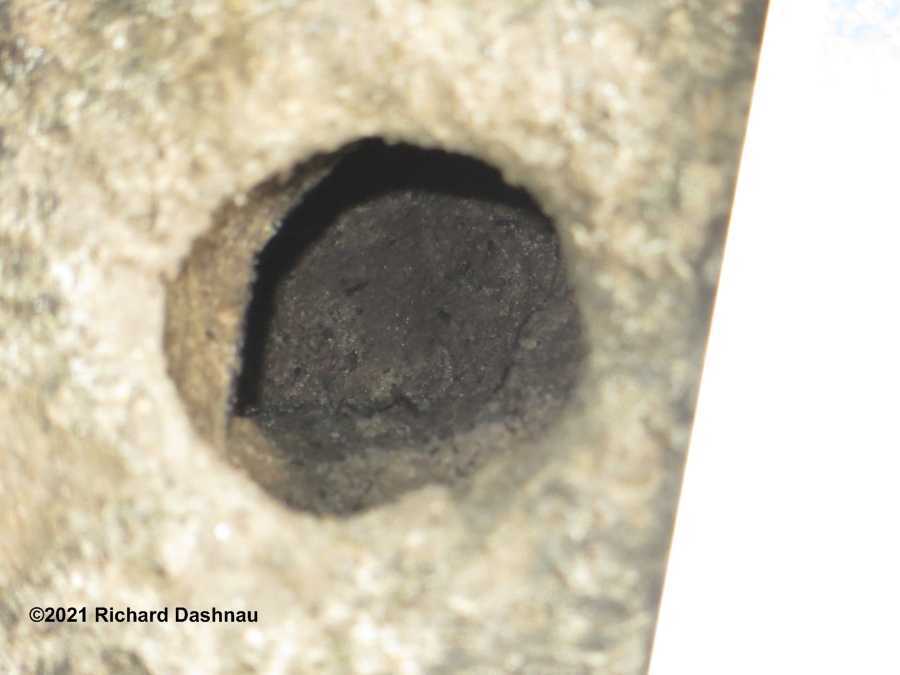
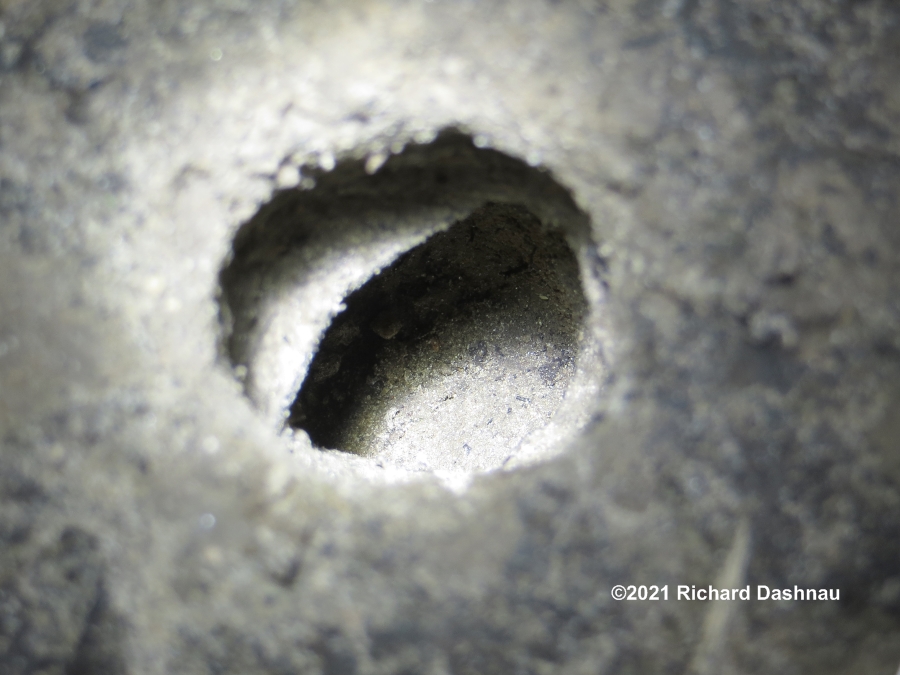
I
was able to see a bit more clearly into the hole than the images show.
So I thought it would be ok to probe a bit with my finger. The mud was
packed, not soft. Also, the narrow
parts are like shelves--that
is, the wall is the same width under it as over it. I
couldn't
tell for sure if the bumps were exposed tree roots. Also, the hole
stops at the bottom, and
does not turn in any direction into
anything horizontal. Finally, I made a "high-tech depth sounding
device" from a twig and placed it into the hole. I pinched it at the
top edge of
the hole, and then-holding by the pinched point-placed
it onto my gauge to get a depth reading. The hole is about 5
inches (13 cm) deep.
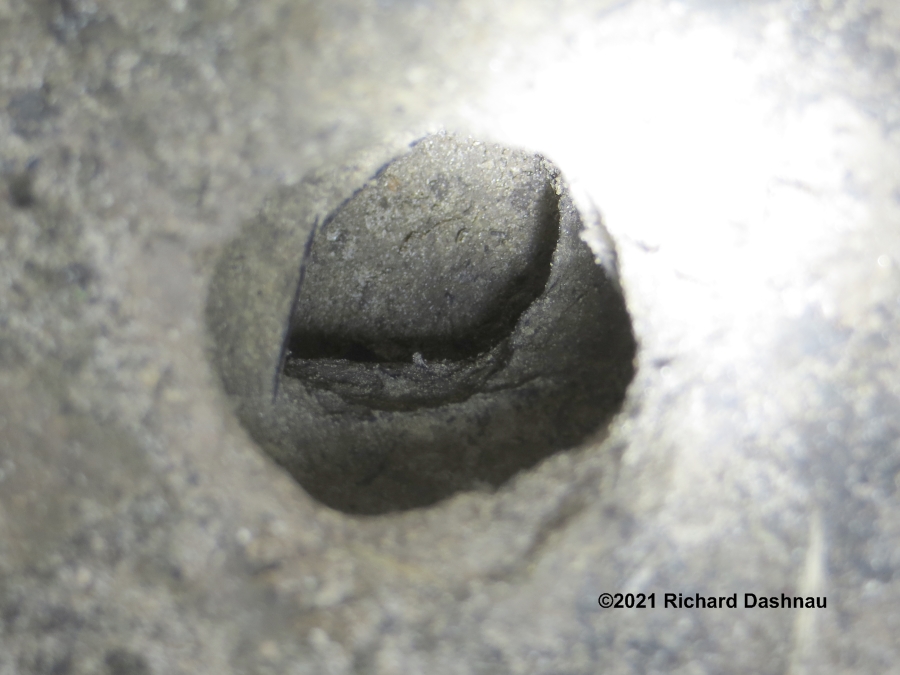
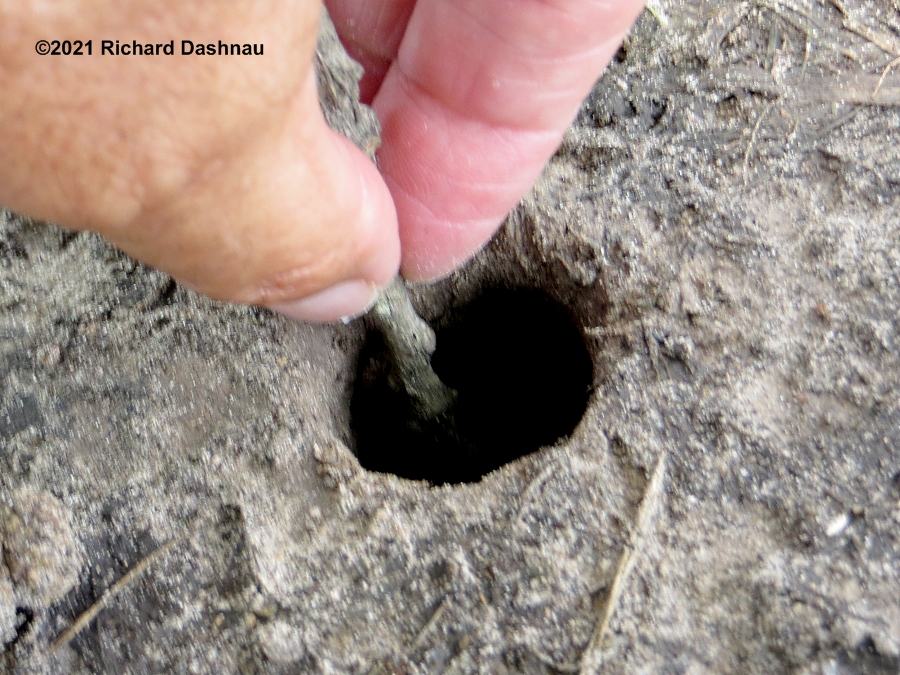
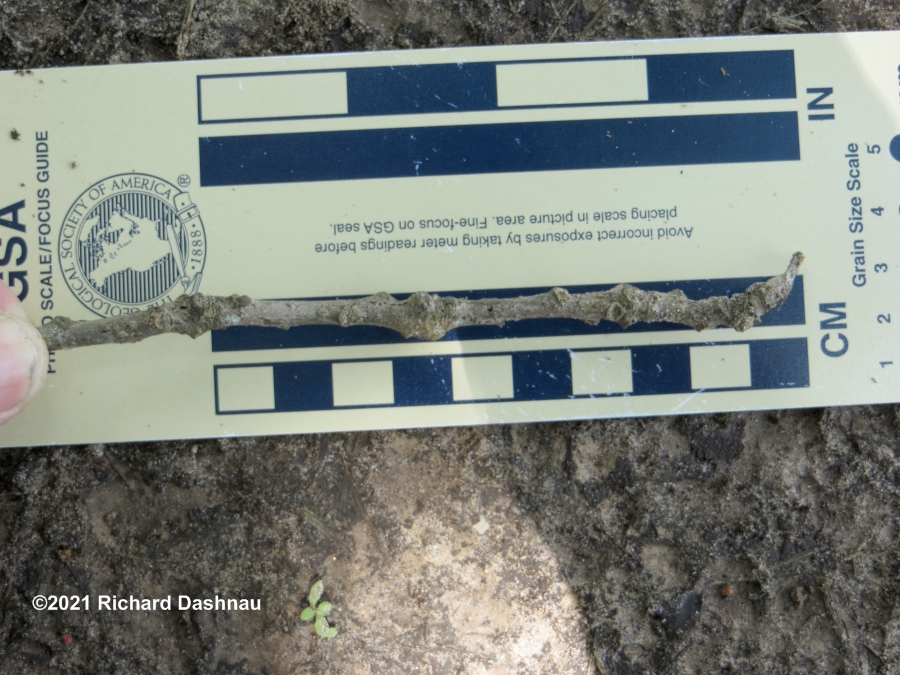
04/09/2009
--I encountered a Squirrel Tree Frog and was able to shoot
some
high-speed video of it as it climbed a tree. While watching the video,
I noticed how the frog occasionally was able
to hold on by just one
front foot. Then I wondered how the frog's foot stuck at all. I was
pretty sure that it was by suction (even though the toe pads look like
suction cups--see below). I searched
online and discovered that
the surface of a tree-frog's toe pads is not smooth. Instead, the
surface is split into many microscopic "tiles". These
sections
are each surrounded by a narrow space.
Mucous is extruded from the
spaces between these "tiles" or "pegs". The mucous wets the
face
of each "tile", which then sticks to a surface by liquid adhesion
(similar to the way a beer glass
can stick to a coaster). The
adhesion of thousands of these microscopic "beer glass bottoms" combine
to form a powerful sticking force. When the frog
moves, it
has to peel its toes off the
surface it is clinging to.
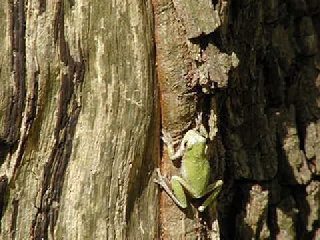
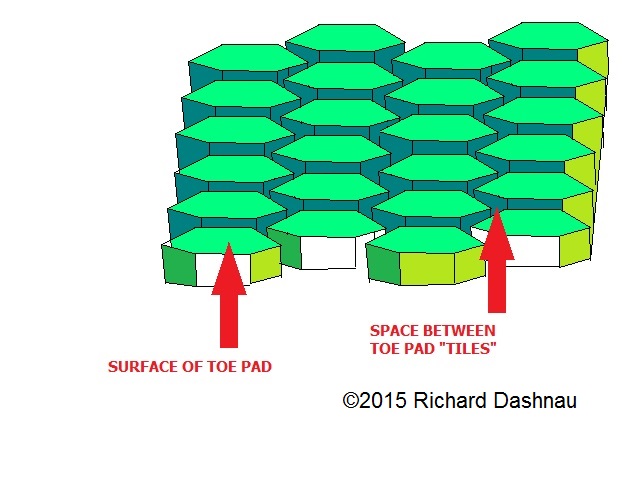
SQUIRREL
TREE FROG CLIMBING (Link to video (wmv))
I found information about this in these papers (I haven't put
links, since they usually expire over time):
ADHESION
AND DETACHMENT OF THE TOE PADS OF TREE FROGS
BY GAVIN HANNA AND W. JON P. BARNES*
1990
The
SEM Comparative Study on Toe Pads among 11 Species of Tree Frogs from
Taiwan
Wen-Jay Lee, Chia-Hua Lue, Kuang-Yang Lue
2001
Wet
but not slippery: boundary friction in tree frog adhesive toe pads
W
Federle, W.J.P Barnes, W Baumgartner, P Drechsler and J.M Smith
J.
R. Soc. Interface 2006 3, 689-697
doi:
10.1098/rsif.2006.0135
2006
October
17, 2004The
image below (GREEN RIDER) shows a little green hitchhiker that landed
on
the argo while I was mashing more rice Sunday.
-------------------------------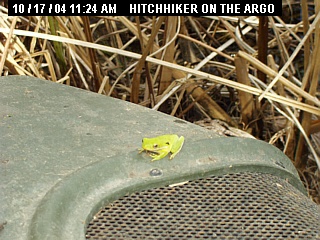
GREEN
RIDER
Actually,
I see these Green Tree Frogs fairly often while in the rice, and
usually
that just land on the argo, or me, and then just jump off. This one,
however,
stayed for a while, and so I grabbed
my "smaller" camera and took some
pictures. They came out really well, I thought, so here they
are.
I can't believe they came out like this!
I
was
got this great closeup (see REALLY CLOSE,
below), and while I had the camera
near it, the frog turned and faced the camera (see GET MY BETTER SIDE,
below). Finally this frog jumped off.
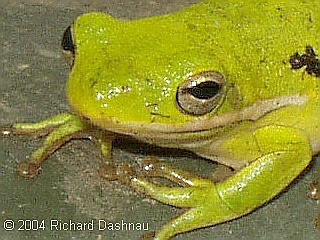 -
-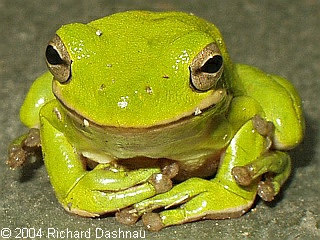 -
-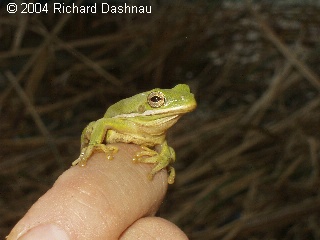 -
-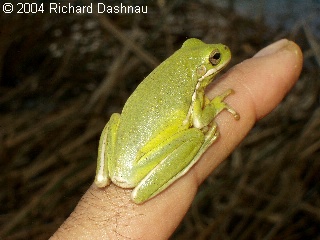 -
-
REALLY
CLOSE
GET MY BETTER SIDE
YOU WANT ME TO JUMP!?
WHAT ARE YOU POINTING AT?
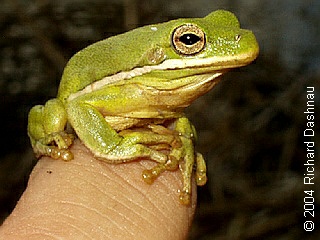
DON'T MAKE ME GO
Later
in the afternoon, I was at it again with the argo, and another frog
jumped
on. This time, I reached for it (with the camera in the other hand),
and
the frog jumped onto my hand. It crawled to
the knuckle of my curled finger,
and posed for a while (see YOU WANT ME TO JUMP. above). After I took a
few pictures, I gently tried to let it jump off, but it wouldn't go. I
extended my finger
(see WHAT ARE YOU POINTING AT, above), and the frog
just crawled around on my hand and finger. It perched on my
knuckle
again, where I got this great picture (see DON'T MAKE ME
GO, above).
It always affects me to have such a small creature trust me like this.
I want to stand still for a while and let it remain. But, I had my work
to do, and I figured the frog would be safer
back in the grass, so I finally
got it to jump to a strand. With a slight twinge, I moved away from my
brief acquaintance.
If
you'd like to know more about the park follow these links:
Brazos
Bend State Park
The main page.
Brazos
Bend State Park Volunteer's Page
The
volunteer's main page.
Go back to my home page, Welcome
to rickubis.com
Go
back to the RICKUBISCAM
page.
Go
back to the See
the World
page.



































